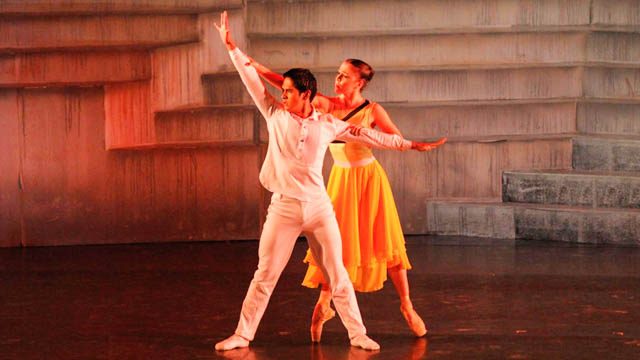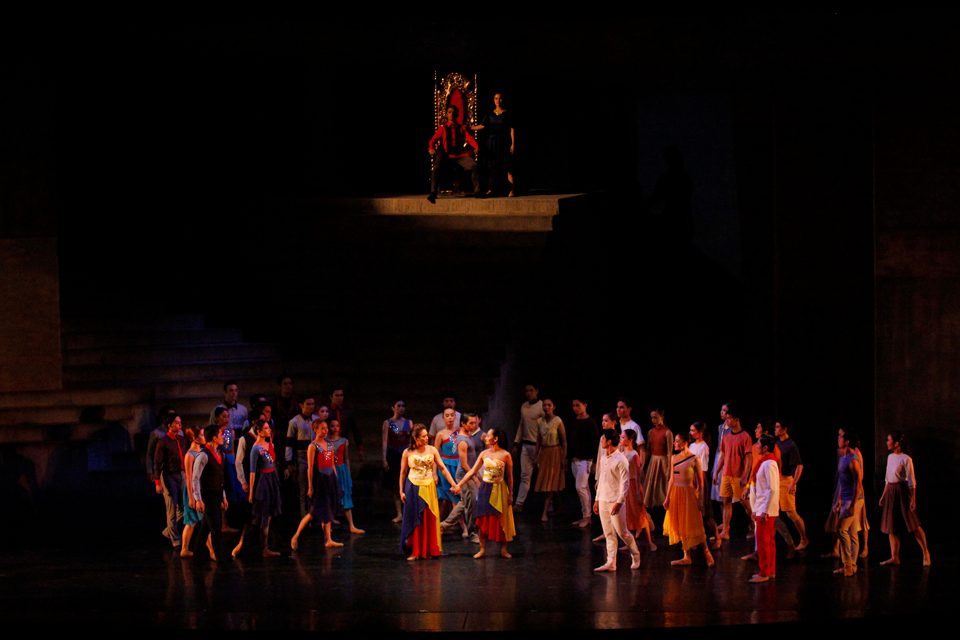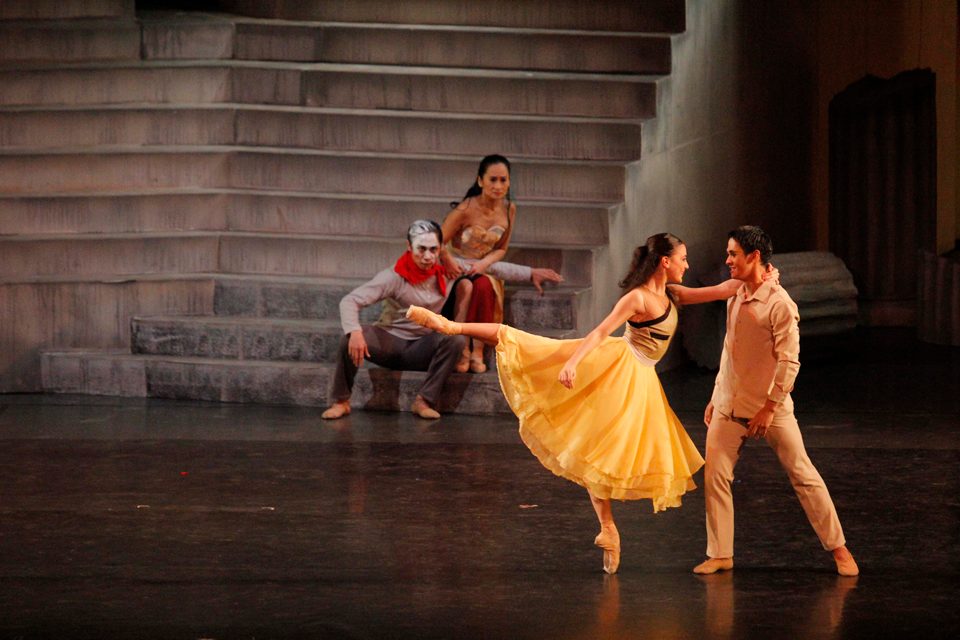SUMMARY
This is AI generated summarization, which may have errors. For context, always refer to the full article.

MANILA, Philippines – Staging any production about recent history is fraught with peril. It can be assailed as partisan or apologist, revisionist or simplistic, reverential or propagandist. Passions still smolder as the trauma of torture has yet to heal, stolen wealth has yet to be returned, and murderers have yet to be brought to justice. To perform recent history onstage is to dance among ruins that still burn.
Into this perilous realm of contemporary political history, Ballet Manila has dared set foot and come out soaring with Rebel, an original neoclassical dance on the People Power Revolt.
Star studded
Rebel premiered on February 25, the 30th anniversary of the People Power Revolt, at Star City’s Aliw Theater, Cultural Center of the Philippines Complex,and performed until the February 28.
Rebel, with libretto by Ballet Manila artistic director Lisa Macuja and choreographer Martin Lawrence, starred Ballet Manila principal dancers Rudy de Dios and Mark Sumaylo alternating as rebel leader and martyr Benigno, Gerald Fransisco and Brian Williamson as the murderous tyrant Ferdinand, Tiffany Chiang and Abigail Oliveros as the plundering tyrant’s first lady Imelda, Katherine Barkman and Dawn Mangahas as Benigno’s spouse and conciliatory president Cory, Michael Divinagracia and Rudolph Capongcol as everyman Juan dela Cruz, and Romeo Peralta as Benigno’s sidekick Jose. Lisa Macuja Elizalde and Sofia Peralta dance as the motherland Inang Bayan while Joanna Ampil shares the stage singing for the same role.
Gerald Salonga conducted the ABS-CBN Philharmonic Orchestra as musical director. The creative team included production designer Mio Infante, lighting designer Joaquin Jose Andranda, costume designer Jeffrey Rogador, and projector designer Ga Fallarme.
Posted by Ballet Manila on Wednesday, 24 February 2016
Ancient and contemporary

Ballet Manila’s Rebel joins other theatrical works that have dealt with the anti-dictatorship struggle such as Philippine Educational Theater Association’s 2013 musicale Pamana [Legacy] on the lives of martyred Senator Benigno Aquino and the late President Corazon Aquino, and Tanghalang Pilipino’s 2008 musicale EJ: Ang Pinagdaanang Buhay nina Evelio Javier at Edgar Jopson [EJ: The Life of Evelio Javier and Edgar Jopson]. But what sets Rebel from other recent historical stage productions is that it fuses the history of a famous Roman slave uprising led by a champion gladiator 2087 years ago with the Philippines’ groundbreaking peaceful citizens’ revolt led by a martyr’s widow 30 years ago.
British choreographer Martin Lawrence explained in his notes, “Rebel incorporates all the dramatic narrative and passion of Spartacus and puts it alongside the 1986 People Power Revolution… I have chosen not to create a ballet that is a dance/history lesson, but rather make a parallels between two events and the main characters: Spartacus/Benigno Aquino, Phrygia/Corazon Aquino, Crassus/Ferdinand Marcos, and Aegina/Imelda Marcos.”
This explains several scenes in the ballet, such as when the murderous tyrant Ferdinand forces captive rebel leader Benigno and everyman Juan dela Cruz to fight to the death like ancient gladiators.
Rebel not only utilized music identified with the People Power Revolt such as “Pilipinas Kong Mahal,” “Magkaisa,” Dahil sa Iyo,” “Bayan Ko,” and “Handog ng Pilipino sa Mundo,” it also utilized music composed by Aram Khachaturian for his 1956 ballet Spartacus.
Ensemble success

Long known for educating the masses with well-loved classical dances, Ballet Manila has proven itself as today’s preeminent Philippine ballet company by being nothing less than a rebel with its original neoclassical performance.
No longer just a ballet company with a smattering stars, Ballet Manila company showcased the depth of its talent among its company members and the symmetry of its ballet de corp. Everyone incendiary.
Ballet dancers are ultimately judged as actors, how they tell their story and express their emotions through the silent language pantomime and dance. And with that as the criterion, Ballet Manila’s dancers successfully performed with verve and pathos.
Katherine Barkman, Tiffany Chiang, Gerald Francisco, and Rudy de Dios all tugged at the heart strings performing as Cory, Imelda, Marcos, and Benigno, respectively, during their performance on the February 27. So clearly did the dancers tell their story that the complete synopsis projected on to a screen flanking the stage before the performance started was rendered completely superfluous.
Despite a few problems with synchronicity, the entire cast performed unforgettable dances. Martin Lawrence’s choreography not only allowed them to tell their story empathically and clearly, it gave them the means to soar and blaze onstage.
The set design by Mio Infante, a towering staircase in industrial concrete gray, was successful not only in projecting the Marcos dictatorship’s trademark brutalist pompousness, it also created a vertical performance space where dancers could climb or descend.
The neutral color allowed Joaquin Jose Andranda’s lighting to change its color and character as needed for each scene while the steps served as the the screen for Ga Fallarme’s video projections of actual historical footages. Jeffrey Rogador’s costumes also make is clear who each character was, despite the limitations imposed by the choreography. (Both Benigno Aquino’s tradmark eyeglass frame and Imelda’s Marcos’ bouffant hairstyle, present in the program photos, would not have survived the choreography and were not used onstage.)
Truth in fiction

Despite being a fictionalized fusion of Philippine contemporary history and ancient Roman history, Rebel’s story must still resonate with reality. The narrative does not establish well enough the Marcos dictatorship’s crimes against the people – the very acts that make him a tyrant and villain.
It does show Ferdinand’s cruelty towards Benigno, but in so doing risks reducing the people’s anti-dictatorship struggle into nothing more than a power struggle between Marcos and Aquino political dynasties. That’s the perspective of this audience member and writer, one who was old enough to have participated in the People Power Revolt of 1986 personally, albeit as a child.
While the distant past can be freely reinterpreted as a metaphor for today’s issues without offending any long-dead antagonists, any telling of recent history will come under the scrutiny of survivors, veterans, and witnesses who most often demand more verisimilitude than any dancer, singer, or librettist can deliver within the limits of the stage or the length of a show.
From an ongoing and complex political milieu that cannot be truly understood without the context of the distant past and that the consequences of which have yet to fully unfold and be understood, artists need to find a story with sense, simplicity, symmetry – one with a discernible beginning, middle, and end.
Often, authors composite several historical personalities into a few allegorical characters that the stage can contain and that audiences can digest. Real people, with all their idiosyncrasies and contradictions, become heroes and villains played by performers.
Ultimately, the need to tell a tale well-told matters even more than portraying history accurately. And Ballet Manila told the tale well in dance and music.
This ballet is essential viewing for millennials who may fall for the revisionist history peddled remnants of the Marcos dictatorship. But beyond its didactic worth, Rebel is a pleasurable performance worth restaging and watching yet again, if only to see Ballet Manila set the stage ablaze with their dance. – Rappler.com
Writer, graphic designer, and business owner Rome Jorge is passionate about the arts. Formerly the Editor-in-Chief of asianTraveler Magazine, Lifestyle Editor of The Manila Times, and cover story writer for MEGA and Lifestyle Asia Magazines, Rome Jorge has also covered terror attacks, military mutinies, and mass demonstrations as well as reproductive health, gender equality, climate change, HIV/AIDS and other important issues. He is also the proprietor of Strawberry Jams Music Studio.
Add a comment
How does this make you feel?
There are no comments yet. Add your comment to start the conversation.